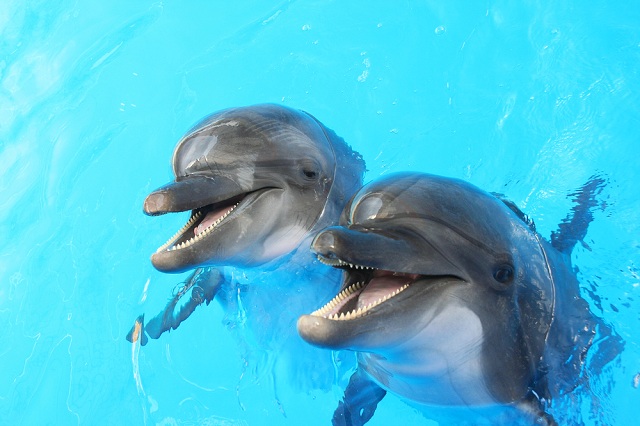In this article you will learn about the main characteristics of dolphins, their habits , how they feed, how they reproduce. See also curiosities about these marine beings. Follow!
Dolphins are mammalian animals, belonging to the phylum cordata and the order of cetaceans. They live in the aquatic environment and are distributed in almost all marine environments on the planet, with the exception of the poles. In our country, the dolphins most commonly found are: pink dolphin, porpoise, tucuxi, gray dolphin, bottlenose dolphin and spinner dolphin.
Dolphins are considered super smart, playful, friendly, docile, interactive and fun. They are believed to be the most intelligent animals in the world , second only to humans.
They have great capacity for socialization and interaction with other species, such as man himself. The strong social bond with other species allows him to form mixed groups with other cetaceans. They are excellent swimmers, like to jump in the water and perform acrobatics.


Dolphins have a great capacity for socialization and interaction with other species (Photo: depositphotos)
Dolphin characteristics
They are animals with a thin body and a fine beak. The dorsal region is dark and the belly is light. Their sharp teeth can range from 80 to 120 pairs. Your vision has a range of 300 degrees. During the sleep of these animals, half of the brain is active and the other half is at rest. This is so that the animal continues to breathe and does not die “drowned”.
Male dolphins are larger than females and the main characteristic of these living beings is intelligence. They are not aggressive , on the contrary, they are very affectionate and sociable. Its size can vary from 1.5 meters to 10 meters in length.
Regarding weight, they can reach 7 thousand kilos , depending on the species. They are considered the most adapted mammals to aquatic life, since the body morphology of these individuals has evolved into a very hydrodynamic shape. This means that the internal and external adaptations of this animal contributed to its success, mainly for diving.
Breath
Like all mammals, dolphins’ breathing is pulmonary , so they go to the water’s surface to perform gas exchange. They do not have a nose, however, they have a hole in the top of the head with the same function, called a vent or spiracle.
The spiracle works as follows: when the animal goes to the surface to breathe, the valve opens and the air is expelled from the lungs. The air is released with so much pressure that water splashes from the surface, making a kind of fountain .
When descending into the water body, the spiracle closes. The dolphin uses oxygen from the air to breathe, not water.
Habits
Dolphins have family habits , usually spend long periods being guided by their mother. This follow-up can last for around 3 to 8 years. They have habits of being helpers, especially when someone in the group gets hurt or falls ill. They always help those who need help.
These animals usually hunt as a team , feeding on octopuses, squids, fish, walruses, etc. When they identify their prey, they swim around them forming several bubbles. These bubbles serve to distract them and thus be easily captured. They have habits of communicating by echolocation, through the emission of several sounds.
They usually feed at night , when visibility in the water is poor. Dolphins use the sound of echoes to find their prey. In contrast, they are easily preyed upon by sharks, sperm whales and humans, through predatory hunting.
When they feel threatened, they have the habit of repeated headbutt to defend themselves. In Japan, dolphin hunting is common, aiming to replace whale meat.
Where they live
Most dolphins live in temperate and tropical oceanic waters , however, a few species can be found in freshwater rivers. Some still live in inland seas, like the Mediterranean, the Red Sea and the Black Sea.
There are about 37 species of dolphins . Because they live in groups, in coastal regions they can group between 10 to 500 individuals. They live well with animals of both sexes.
Dolphin Facts
What they eat?
Dolphins feed mainly on cephalopods, such as marine mollusks ( octopus and squid ) and fish in general. To locate their prey, they use the echolocation technique.
They emit high frequency sounds that bring information about what is in the environment in front of them, including the distance, shape, texture and constitution of the material. Such sounds are not audible to humans.
Dolphin is not a fish?
Many people think that the dolphin is a type of fish, but it is a mammal , belonging to cetaceans. Although they live in the aquatic environment, they are not fish .
Is this animal a mammal?
The dolphin is a mammal well adapted to the aquatic environment. Like all mammals, they have mammary glands , lung breathing and are warm – blooded animals . The largest species of dolphin in the world is the orca and the smallest is the boto-tucuxi.
What covers your body?
Dolphins have no hair, their skin is smooth and massive , with elastic characteristics . These elasticities allow the animal to suffer a deformity when moving in the water body.
When the animal is swimming at a low speed, the skin is smooth, without changes. When it travels at a high speed, the skin deforms to absorb turbulence, thereby increasing its speed.
Dolphins’ skin is constantly renewed , being very sensitive to touch. This sensitivity to touch makes the animal easily hurt, however, it has a high healing power.
The dolphins’ bodies are covered by a thick layer of fat which acts as a thermal insulator, keeping them warm even under water. This layer of fat also helps these animals during swimming.
Images of these marine animals


(Photo: depositphotos)


(Photo: depositphotos)


(Photo: depositphotos)


(Photo: depositphotos)


<!–
–>
